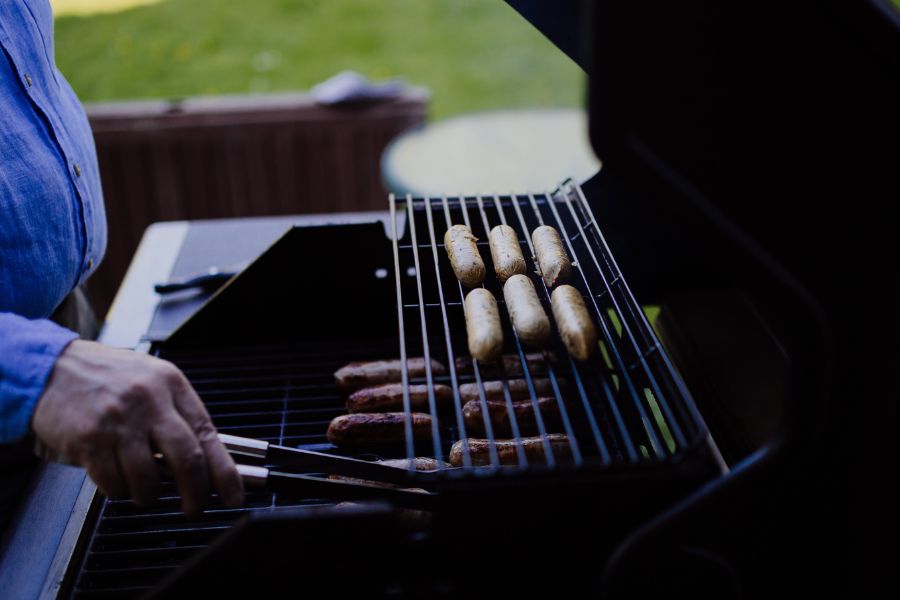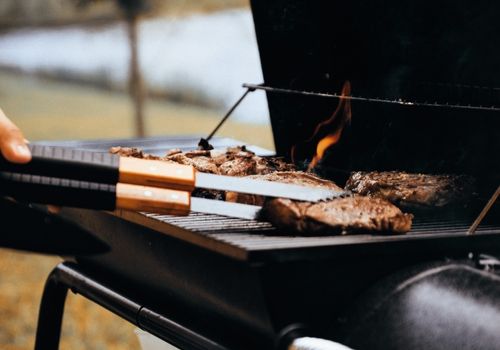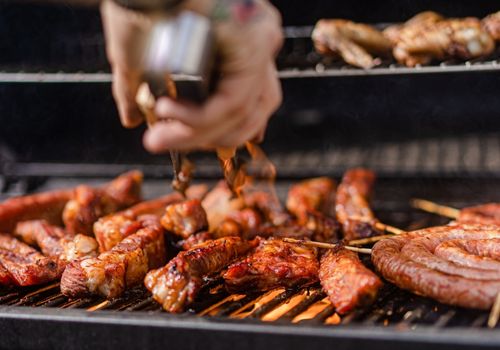There is no single answer to settle the vertical vs offset smokers debate. The main difference between the two appliances is their orientation. Offset smokers are horizontally inclined while vertical smokers are vertically inclined.
This is what leads to most of their variations such as heat distribution, usage of space, and energy consumption. That being said, I do have an affinity for my reverse flow offset smoker, simply because it is more energy and heat-efficient.
Having worked as a steakhouse prep cook, I’ve had the chance to use both offset and vertical designs for different recipes. I know the strengths and weaknesses of both these appliances so let me help you decide which one will work best for you.
This article is a side-by-side comparison of both types of smokers based on their features and specifications. I will also tell you how the different smokers work and give you my opinion on the best overall model for each one:

Feature | Offset Smoker | Vertical Smoker |
Orientation | Horizontal | Upright |
Fuel Efficiency | High | Low |
Energy Efficiency | Low | High |
Heat Distribution | Horizontal | Upwards |
Space Efficiency | Less Space Efficient | More Space Efficient |
Grilling Capabilities | Can Function as a Grill | Cannot Function as a Grill |
Potential Cooking | Small | Large |
This offset vs vertical smoker comparison is based on several key features:
An offset smoker is also commonly referred to as a horizontal smoker because its orientation differs from a vertical model.
The offset model is inclined horizontally, while the vertical smoker is built bold upright.
This feature is the pacesetter for this offset smoker vs vertical smoker debate. It gives rise to almost all the other differences including heat distribution, space-saving capacity, and energy efficiency.
Both offset and vertical models come in different sizes that offer different cooking surface areas but the build of a vertical smoker is more compact. This makes it easier to fit into small spaces, compared to offset smokers.
The average horizontal smoker will take up more floor space in your patio or kitchen, compared to a vertical smoker that offers similar features.
Because of this difference in space requirements, it’s more common to find a vertical smoker in the kitchen, whereas offset smokers are often associated with outdoor cooking.
Heated air moves upwards and this is the case for a vertical smoker. It is not uncommon for meat cuts cooking at the bottom of the chamber to get overcooked or dry out.
Horizontal smokers don’t have this issue. On the contrary, they are designed to enhance the distribution of heat and smoke through the cooking chamber.
If you opt for a reverse-flow horizontal smoker, as opposed to regular offset smokers you are guaranteed, smokier, more flavorful meats. A reverse-flow model redistributes smoke and heats back into the cooking chamber before it is expunged from the system through the chimney.
The compact build of the vertically inclined smoker makes it more energy-efficient. This means that it can get more cooking done with less fuel compared to other smokers.
If you grill occasionally, this shouldn’t concern you, since the difference will be negligible. Regular, large-scale grillers are not so lucky. They are bound to note this difference.
Vertical models rely largely on their build to boost the heat flow and insulation while the offset design relies on the material of the body to prevent heat and smoke loss. For this reason, newer models of offset smokers offer dual-wall insulation.
Due to their different designs, the horizontal offset smoker and vertical smoker have varying cooking capabilities.
The offset design supports both smoking and grilling. Almost all of them come with a spacious grilling surface.
Vertical smokers don’t come with an inbuilt grill and their design doesn’t allow you to improvise it as a grill. This gives the horizontal smoker an edge when it comes to this offset vs vertical discussion.

Whether you are working with vertical or horizontal smokers, ash from the burnt wood chips and grease management is part and parcel of the grilling.
Different smokers will have different cleaning systems like ash cleanout features and drip buckets to make cleaning easier.
These features vary across different brands and models and are not influenced significantly by the orientation of the grill.
Generally, offset smokers cost more than vertical smokers.
If you’re looking for an appliance to only suit your smoking needs, you can take advantage of the lower prices of vertical smoker models.
If your budget is flexible, I recommend going for the horizontal smoker to get the convenience of both a grill and a smoker in one appliance.
Offset smokers have two chambers which makes it easy to add wood chips when needed, without having to open the cooking chamber. Most vertical smokers have one chamber meaning that whenever you need to replenish the wood chips, you will have to open the entire chamber. This is especially so for single-chamber vertical smokers.
This interruption gives the precious hot air and smoke within the food chamber a quick escape and allows cold air into the system costing you more time and fuel.
Offset smokers are also called horizontal smokers or firebox smokers. They feature a tiny firebox that filters smoke and heat through to a larger cooking chamber that is connected to it.
The heat and smoke are then purged from the cooking chamber through a chimney. The chimney is placed farthest from the firebox.
Then there is the reverse flow offset smoker models built to be more heat and energy-efficient. Instead of having a firebox, a reverse flow offset smoker features an extra heat baffle plate that sits right below the cooking chamber.
This baffle plate is a thick steel plate full of holes. It serves 2 purposes:
Reverse offset smokers are easy to distinguish from the traditional vertical smoker because their chimney is fitted at the end of the cooking chamber, very close to the firebox. The traditional offset design has its chimney fitted far from the firebox.
This serves to get the heat and smoke to pass over your meat again, making sure it cooks evenly. Hence the name, reverse flow.

One of the best offset smokers is the Oklahoma Joe's Longhorn reverse flow smoker. Here’s why:
The exterior of this horizontal smoker is made of heavy gauge steel. It is fitted with four ceramic baffles for better energy consumption.
The firebox and cooking chamber are housed separately, so you won’t interrupt your grill when you are refueling.
One feature I appreciate about this smoker is the movable smokestack. This will allow you to either use the smoker as a traditional offset smoker or a reverse flow smoker.
It runs on either charcoal or wood and offers a total cooking space of 1060 square inches. An upper rack offers 309 sq. inches, while the lower rack offers 751 sq. inches of cooking space.
The Oklahoma Longhorn Reverse flow smoker comes with a two-year warranty period on all its components.
If you would rather get a traditional offset smoker, consider a fuel-powered Royal Gourmet offset smoker for your smoking and grilling needs.
A vertical smoker refers to an upright smoker. With vertical smokers, the firebox is positioned at the very bottom of the food chamber.
Vertical smokers work by moving heat and smoke upwards, passing a minimum of two racks as it exits the chamber through a chimney.
To ensure sufficient moisture content in the food chamber, a water pan sits right between the cooking chamber and the heat source.
Most vertical smokers utilize charcoal or wood placed in the firebox at the bottom of the food chamber.
Vertical offset smokers feature a separate firebox that is joined to the food chamber by an internal damper. It looks like a blend of vertical and horizontal smokers.
Vertical offset smokers are classified as vertical smokers because the food chamber stands upright.
There are many types of vertical smokers but the main difference to look out for is the fuel type they run on.
The options include charcoal vertical smokers, wood-fueled vertical smokers, electricity-powered vertical smokers, ugly drum smokers, propane smokers, box smokers water smokers, and gas-powered vertical smokers.
The choice depends on which types of fuel you’re partial to and what is easily available.

If I were to purchase a vertical smoker today, I would go for the Pit Boss Sportsman 5 Series.
This vertical smoker gives you a temperature range of 150°F to 450°F making it perfect for low and slow cooking methods like barbecuing and smoking.
When cranked up to its highest temperature this grill can double up as a wood oven that can make great pizzas and casseroles.
The Pit Boss 5 Series is a fuel-powered smoker whose temperature is controlled by an LED display at the top of the unit. It displays the internal temperature of the food chamber, as well as the readings from your meat probes.
The body of The Sportsman is made of heavy-gauge stainless steel, while the cooking racks are coated with porcelain.
It has 5 adjustable cooking grates to maximize the cooking space available, meaning that you can cook different cuts of meat on them. You can go small with a rack of baby back ribs or big with a full turkey for Thanksgiving
The Sportsman by Pit Boss offers a large cooking space of 1,513 square inches which is more than sufficient for large gatherings. It also has a 40 lb pellet hopper capacity which will take you through long cooks without having to refuel.
My favorite feature of this small grill is the prime button. It is a wonderful addition that enables you to either increase the smoke output or give the smoker a turbo boost after it has been opened.
The only thing I don’t like about this vertical smoker is the hopper grate. The hopper grate is simply a safety feature that prevents you from putting your arm inside the hopper.
As much as this feature comes in handy to protect children, it makes it harder to reach all the leftover pellets in the hopper.
That said, the Sportsman does deliver when it comes to results in the ease-of-use. I definitely recommend it.
If this vertical smoker piques your interest, you should also consider the Weber Smokey Mountain vertical smoker.
Having looked at the pros and cons of the offset and vertical smoker, it makes sense to think of merging the two to get the best of both worlds with vertical offset smokers. If this is the route you have chosen, go with the Dyna-Glo vertical smoker.
This vertical offset smoker runs on charcoal. Its outer material is made of stainless steel and it comes with six cooking grates.
It offers a large cooking space of 1,176 sq. inches and each grate can support up to 25 lbs. The charcoal chamber is constructed of porcelain-enameled steel to ensure your fuel is tightly stacked. For easier cleaning, it features a large, removable ash pan that is easy to empty.
What stands out about the Dyna-Glo vertical offset smoker is the ‘smoke zone’ which helps to adjust the smoke settings to your preference.
Vertical models are better than offset models in some ways, like floor space requirements. Similarly, the offset model is better than the vertical smoker when it comes to heat efficiency.
A smoker is a general term that refers to any appliance capable of smoking meat. An offset design describes a smoker whose firebox is hosted ‘off the set’.
Both sides bring up good arguments for this offset smoker vs vertical comparison, but the bottom line is that both types of smokers can get the job done. That said, there are notable differences in the final product.
For starters, if you want a deep, smoky flavor embedded in your meat, it requires thick smoke to cook in. That is what you get with an offset model. If you want a smoker that is eco-friendly, affordable and takes up less of your floor space, try the vertical model.